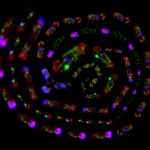Lien vers Pubmed [PMID] – 16188435
Curr. Opin. Genet. Dev. 2005 Dec;15(6):614-20
With more than a dozen species fully sequenced, as many as this partially sequenced, and more in development, yeasts are now used to explore the frontlines of comparative genomics of eukaryotes. Innovative procedures have been developed to compare and annotate genomes at various evolutionary distances, to identify short cis-acting regulatory elements, to map duplications, or to align syntenic blocks. Human and plant pathogens, in addition to yeasts that show a variety of interesting physiological properties, are included in this multidimensional comparative survey, which encompasses a very broad evolutionary range. As major steps of the evolutionary history of hemiascomycetous genomes emerge, precise questions on the general mechanisms of their evolution can be addressed, using both experimental and in silico methods.

